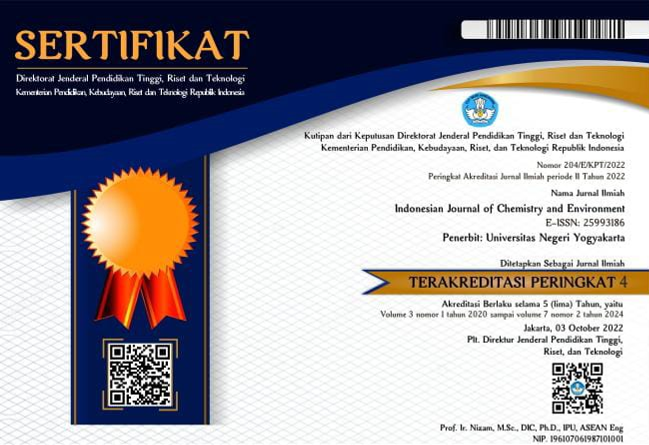Preparation of Magnetite-Tannin Guava Leaves as Pb(II) Adsorbent
DOI:
https://doi.org/10.21831/ijoce.v4i2.48400Abstract
The increasing use of heavy metals in everyday life causes serious environmental pollution, one of which is the Pb(II) metal ion which is toxic to organisms. This study aimed to modify the tannins extracted from guava leaves with magnetite (Fe3O4) by coprecipitation as adsorbent of Pb(II) metal ion. The modified results were characterized using Fourier Transform Infra Red (FTIR), Scanning Electron Microscopy (SEM), Energy Dispersive X-ray (EDX), and X-Ray Diffraction (XRD). Metal ion levels of Pb(II) before and after adsorption were measured by Atomic Absorption Spectroscopy (AAS). The results showed that the tannins increased the magnetite-tannin crystal size from 85.17 to 155.66 nm. Modification of magnetite (Fe3O4) in guava leaf tannins is able to provide magnetic properties that facilitate post-adsorption separation. The optimum adsorption conditions were reached at pH 7 for magnetite-tannin and magnetite with optimum contact time. The adsorption of magnetite-tannin and magnetite occurred at 90 and 60 minutes. The maximum adsorption capacity of Pb(II) metal ions by magnetite-tannin is smaller than that of magnetite. Both adsorption processes followed the Langmuir isotherm pattern and Pseudo Order Two (Ho) kinetics.
Downloads
Published
2022-03-10
How to Cite
[1]
Rusmana, M.H.G. and Sulistyaningsih, T. 2022. Preparation of Magnetite-Tannin Guava Leaves as Pb(II) Adsorbent. Indonesian Journal of Chemistry and Environment. 4, 2 (Mar. 2022), 39–48. DOI:https://doi.org/10.21831/ijoce.v4i2.48400.
Issue
Section
Articles
Citation Check
License
Authors who publish with this journal agree to the following terms:
- Authors retain copyright under a Creative Commons Attribution–ShareAlike License (CC BY SA) that allows others to share: copy, and redistribute the material in any medium or format, Adapt: remix, transform, and build upon the material, for any purpose, even commercially.
- Authors are able to enter into separate, additional contractual arrangements for the non-exclusive distribution of the journal's published version of the work (e.g., post it to an institutional repository or publish it in a book), with an acknowledgement of its initial publication in this journal.
- Authors are permitted and encouraged to post their work online (e.g., in institutional repositories or on their website) prior to and during the submission process, as it can lead to productive exchanges, as well as earlier and greater citation of published work.










